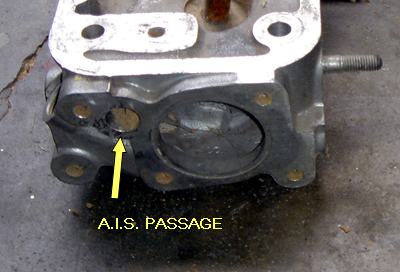| Revision as of 06:46, 25 May 2015 ddgonzal (Talk | contribs) (->50) <- Previous diff |
Revision as of 07:00, 25 May 2015 ddgonzal (Talk | contribs) (->50) Next diff -> |
||
| Line 8: | Line 8: | ||
| [http://datsun1200.com/modules/myalbum/photo.php?lid=23894 http://datsun1200.com/uploads/photos/23894.jpg] | [http://datsun1200.com/modules/myalbum/photo.php?lid=23894 http://datsun1200.com/uploads/photos/23894.jpg] | ||
| + | = EGR = | ||
| + | All B211 (from December 1975) and VB210 (from October 1975) used [[EGR]] Exhaust Gas Reduction. This included Vans which were not fitted with catalytic converters. | ||
| + | |||
| + | = Catalyst = | ||
| Nissan system's of exhaust gas cleaning by catalyzed oxidation ([[NAPS]]) adopted. A 2-way [[wikipedia:catalytic converter|catalytic converter]] converted carbon monoxide (CO) and unburned hydrocarbons (HC) to produce "harmless" carbon dioxide (CO2) and water (H2O). It was only later than CO2 was acknowledged to be a pollutant itself. NOTE: In 1980 the 3-way converter introduced a 3rd reaction to reduce the third major pollutant NOx. | Nissan system's of exhaust gas cleaning by catalyzed oxidation ([[NAPS]]) adopted. A 2-way [[wikipedia:catalytic converter|catalytic converter]] converted carbon monoxide (CO) and unburned hydrocarbons (HC) to produce "harmless" carbon dioxide (CO2) and water (H2O). It was only later than CO2 was acknowledged to be a pollutant itself. NOTE: In 1980 the 3-way converter introduced a 3rd reaction to reduce the third major pollutant NOx. | ||
| - | To enable efficient conversion, extra oxygen is introduced into the exhaust system by use of Nissan A.I.S., using either an active air pump ([[Smog Pump]]) or a passive air induction (tuned pulse-flow) system. This uses a cylinder head with an air passage drilled from front to back. | + | To enable efficient conversion, extra oxygen is introduced into the exhaust system by use of Nissan A.I.S. ([[Emission_Controls#Air Injection System|Air Injection System]]), using a passive air induction (tuned pulse-flow) system. It used a cylinder head with an air passage drilled from front to back. |
| [http://datsun1200.com/modules/myalbum/photo.php?lid=23097 http://datsun1200.com/uploads/photos/23097.jpg] | [http://datsun1200.com/modules/myalbum/photo.php?lid=23097 http://datsun1200.com/uploads/photos/23097.jpg] | ||
Revision as of 07:00, 25 May 2015
度排出ガス規制適合
Contents |
50
"H" is the 1975 (50年度) emission standards. Also in 1975 in the United States similar regulations came into effect.
* H-B210 meets H-level emission standards * H-B120 from 1975 uses NAPS-A engine A12
EGR
All B211 (from December 1975) and VB210 (from October 1975) used EGR Exhaust Gas Reduction. This included Vans which were not fitted with catalytic converters.
Catalyst
Nissan system's of exhaust gas cleaning by catalyzed oxidation (NAPS) adopted. A 2-way catalytic converter converted carbon monoxide (CO) and unburned hydrocarbons (HC) to produce "harmless" carbon dioxide (CO2) and water (H2O). It was only later than CO2 was acknowledged to be a pollutant itself. NOTE: In 1980 the 3-way converter introduced a 3rd reaction to reduce the third major pollutant NOx.
To enable efficient conversion, extra oxygen is introduced into the exhaust system by use of Nissan A.I.S. (Air Injection System), using a passive air induction (tuned pulse-flow) system. It used a cylinder head with an air passage drilled from front to back.
No feedback was used to control the fuel system. A carefully tuned carburetor was sufficient.
20905 CATALYST 20905-H7401 * JAPAN B211 A12.S,K 7512- * JAPAN HB211 A14.S,K 7512- * JAPAN GB211 L16 7602- (51 year standard) * not used on Van
53
"E"
1978 emission standard
53年度排出ガス規制適合車

![[Datsun 1200 encyclopedia]](/wiki/upload/wiki.png)
